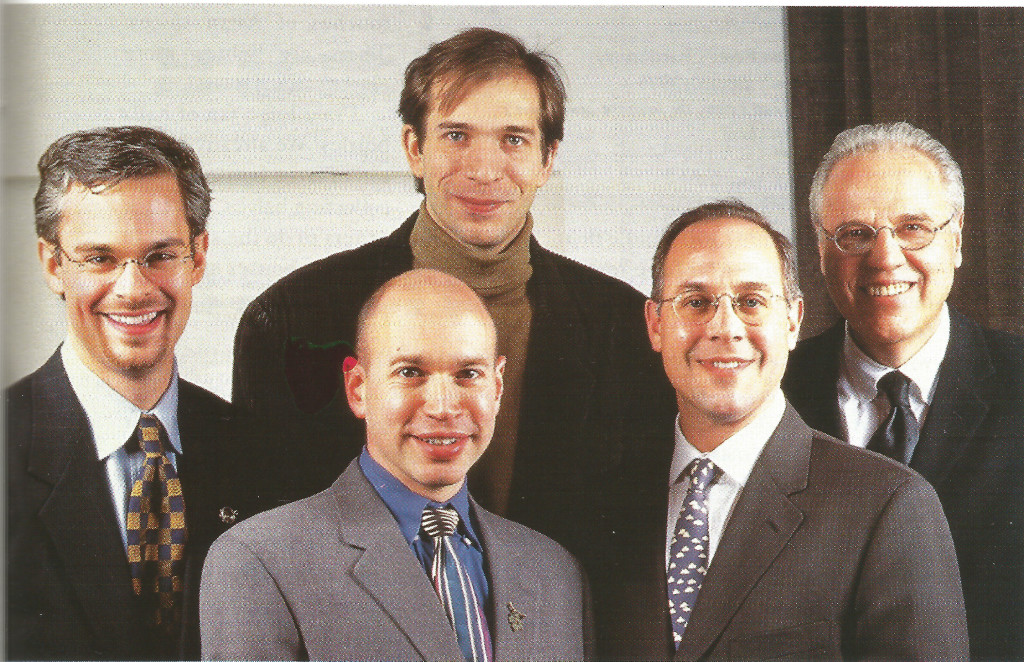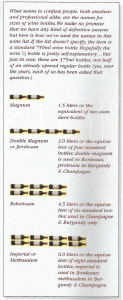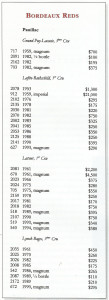Santé
The Magazine for Restaurant Professionals
April/May 1999
Page 59Putting It All Together

The Veritas team, back row from left, Sommelier David Singer, Sommelier Ben Breen, Owner Gino Diaferia, front row from left, Wine Director Dan Perlman, General Mananger Ron Lybeck
The phone rings early. The voice on the line says, “X told us to call you. We’re opening a restaurant. We have a private collection of 70,000 bottles of wine to create a reserve list, but if you want to add to it, you can buy what you think you need. We’re going to do low markups to attract people who are into wine. The chef is really talented. Even though it’s a 65-seat restaurant, you’re going to have two assistant sommeliers. We’re opening in four weeks. Interested?”
I’ve just finished my first pot of coffee. The caffeine hasn’t quite kicked in. I’m highly susceptible to both flattery and intrigue. At least I can go talk to these guys. It’s not as if I’m committing to anything… Yeah, sure.
I go chat. Two weeks later, I’m at 20th Street in Manhattan, sitting in the basement of a construction site that will become Veritas, wondering just where I’m going to put 1,500 selections of wine. I have room for 500 – if I squeeze.
Taking Stock
Reality can bring tears to your eyes. There are personalities involved – four owners, three of whom are offering their personal wine collections for me to cull through. What complicates matters is that each of them has their own idea about what should be on the list. One partner hands over his entire collection. A second sends a list of what he is contributing to the restaurant. Partner number three knows what he has – it just isn’t written down anywhere. I make a trip to his cellar, and we comb through his collection.
I end up with over 1,200 selections of wine. They are heavily concentrated in “trophy” wines – top-growth Bordeaux, Burgundy and Rhône, California cult Cabs, Barolo, scattered selections from Spain (a large vertical of Unico) and Australia (ditto for Grange). There are few whites, lots of big bottles (25 percent is in magnum or larger) and virtually no half-bottles.
My two cellar rooms are both temperature controlled. I create “red” and “white” roooms, with double-depth, single-bottle racking. Initially, my reaction is one of dismay; how am I going to create bins?, there’s a lot of wasted space, etc. When I stop to think about how the wines are coming in, however, I realize that this configuration is necessary. Traditional bins would end up with five or six different wines piled on top of each other. On the other hand, because of the “selection” process, I can’t preassign bin numbers and spacing to wines. I end up creating bin number categories (e.g., 2000-2200 for red Bordeaux) and then assigning the bin numbers as the wines arrive.
Collaboration
There are two assistants to hire, one capable of creating the bar that will carry eclectic and interesting selections, not “well” brands and not even standard “call” brands. Also, I want someone who can manage a small, constantly changing, wine-by-the-glass program. We interview and hire, and we put one of the assistants, David Singer, on payroll and get him working. Between the two of us and General Manager Ron Lybeck, also a sommelier, we hammer out the concept, and Singer starts making selections. My second assistant, Ben Breen, joins us. He not only will handle floor service, but also much of the restaurant’s computerization, including the redesign of the preliminary web site where our wine list and menus are posted.
Lybeck and I come up with the concept of a “market” list. We approach it like a chef going shopping, finding ingredients and then creating a menu. I’m not going to worry about filling holes in this list. I look for wines that I like, that I can get at good values and offer at prices that beat the competition. We collect wine lists from all over the city and start comparing prices. If someone bought something years ago, we may not be able to beat the price. Instead, we go for giving the best value that we can.
There’s the menu to consider. Executive Chef/Owner Scott Bryan and I worked together years ago in another restaurant. Initially, his menu looks like typical fusion cuisine, but he has his own twists. Aiming for simplicity in a city where more is better, he pairs a minimum of ingredients to create a maximum effect. We taste through the menu with the staff – the food is amazing! From my perspective as Wine Director, however, most of what’s on the reserve list doesn’t pair with the food. A huge percentage of these are big, “chewy”wines. The food is lighter and simpler with touches of Asian spices. There are lighter, more elegant wines to add.
I’m a huge fan of half-bottles. We already have a ton of large bottles. I start collecting halves, and I ask one of the partners to do the same. He heads for the auction houses and starts bidding.
Presentation
I wish that I could remember the thought processes that went into the list design. I do remember waking up in a cold sweat at four in the morning and jotting down nightmares. Some of the presentation was dictated by prior decisions; a designer already had selected the physical book that would contain the list. It’s a half-width ring binder holding sheets of paper that are 4¼ by 11 inches. I decide to print pages on one side and fold them in half. The physical design allows me to update the list daily, a necessity given the wine-crazed clientele that we attract. Customers expect that the wine they see on the list to be there; being out of one item is guaranteed to convince them that we’re all smoke and mirrors.
 I decide on a reference section for the list. Customers are always asking questions about bottle sizes, geography and wine trivia. I create a chart of bottle sizes, and I add some maps. Inspiration strikes, and I spend a couple of days researching an idea. I gather reviews of a recently released wine. As we all know, wine reviews vary considerably. I insert a blurb about the importance of trusting one’s own palate and quote from the reviews. Every flavor profile is different and the ratings vary widely. I show it to colleagues. They love it.
I decide on a reference section for the list. Customers are always asking questions about bottle sizes, geography and wine trivia. I create a chart of bottle sizes, and I add some maps. Inspiration strikes, and I spend a couple of days researching an idea. I gather reviews of a recently released wine. As we all know, wine reviews vary considerably. I insert a blurb about the importance of trusting one’s own palate and quote from the reviews. Every flavor profile is different and the ratings vary widely. I show it to colleagues. They love it.
I want color on the list – just enough to accent the pages. I purchase an inkjet printer, which means slow printouts and regular replacement of pages when someone smears the ink with wet or greasy fingers, but we all like the look. I want to feature wines by the glass up front. A last minute call to the designer yields a pocket added to the inside cover.
We decide that we’re going to have the market and reserve lists in the same book. We want a certain level of impact in dining and wining here. We don’t want people to feel intimidated asking for the reserve list.
I gather a hundred selections or so as an opening market list. Given our “market” approach, I opt for separating them by varietal, not geography. I write a one-sentence blurb for each wine, but as time goes on, we’ll use commentary from staff tastings.
[Veritas – marketlist]
The reserve list requires a different approach. I go after it with a copy of a wine atlas in one hand. I try different formats until I find one that we all like. The page width requires certain decisions. I don’t want individual wines to take up two or three lines of text. My solution amounts to an outline of the wine world; true, customers must look at the top of the page to know where they are on the planet, but my scheme gives a simple categorization to the list.
Training
I have to deal with staff training. I decide that, over time, we will cover the equivalent of a sommelier’s course for the entire staff. Most of the wine education will be handled by me. I decide to leave the spirits education in Singer’s hands; though he’s new to managing a bar and teaching, it is a perfect opportunity for him to grow into a position.
The chef is approached. He’d love to have the kitchen staff participate. We plan classes and tastings, a demanding schedule that will tax the staff’s time and energy. The waitstaff is hired with that in mind. We look for people wo are personally into wine right from the start.
First Returns
Opening day arrives. The reserve list will open with holes intact. It will be a constantly evolving list, as any good wine list should be. Everyone says that their list is constantly evolving, but most aren’t. They become static creations because no one has the time to constantly update them. Our approach has to be different, and my assistants will free more of my time to do that.
I wish I had months to add more whites and to add wines from other parts of the world. I’d like to see more wines representing the lighter side of life. Balance will come with time. On the other hand, we know that the public, and the critics, will come looking for the holes and, finding them, will assume that we haven’t thought it through.
I add an opening statement onto the first page of the wine list, explaining our concept and evolutionary approach. It has no effect on a restaurant critic who arrives before we open, looks at a draft of the list and pronounces judgment on it. One shows up the day after we open and announces that we don’t have the wine that the reviewer wants. We have 11 other vintages of the very wine, but… yawn… well, an interesting list. A neighborhood restaurateur comes in, combs through the list and asks for an obscure wine. “You don’t have it? I thought you were going to cover everything.” He leaves, no doubt to return to his own restaurant and pass the word about Veritas’ inadequate wine list.
After a day or two, I realize that when you come into the New York City market with what we are offering, this reaction is unavoidable. Most patrons and colleagues are excited for us. There are always going to be those who feel that they have to criticize. We have over 1,300 wines on a brand new list. We’ll never cover everything. If we tried to cover everything in a list this size, we’d have one selection from each appellation, and that’s about it. Who’d be interested? Who’d be excited?
Santé is a glossy format trade magazine for restaurant wine buyers and educators. I wrote as a freelancer for them on and off from the first issue in November 1996 until November 2002 when they decided to stop using freelance writers.





 It shouldn’t surprise anyone to find out that there are a whole lot of gay wine geeks and collectors in the world; and they were out in force at the Masters of Food and Wine 2008 in Buenos Aires. Upon arrival, I found myself amidst the swirl of hors d’oeuvres, flagons of wine, internationally acclaimed chefs, sommeliers, restaurateurs, and collectors who were willing to ante-up the air fare, hotel costs, and entrance fees-all of which added up to somewhere around $6,000.
It shouldn’t surprise anyone to find out that there are a whole lot of gay wine geeks and collectors in the world; and they were out in force at the Masters of Food and Wine 2008 in Buenos Aires. Upon arrival, I found myself amidst the swirl of hors d’oeuvres, flagons of wine, internationally acclaimed chefs, sommeliers, restaurateurs, and collectors who were willing to ante-up the air fare, hotel costs, and entrance fees-all of which added up to somewhere around $6,000.

